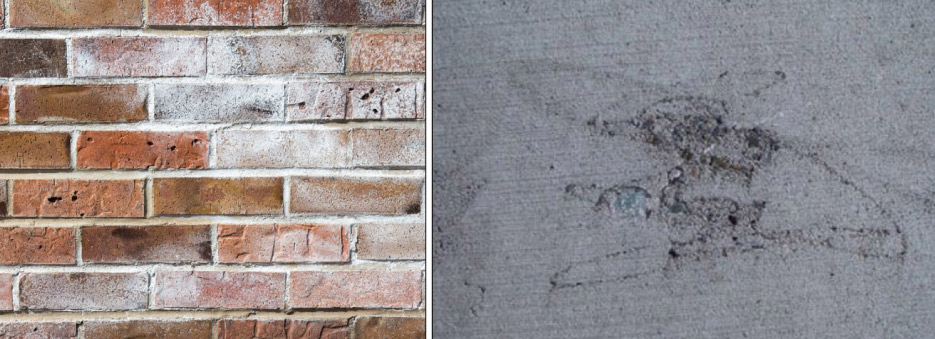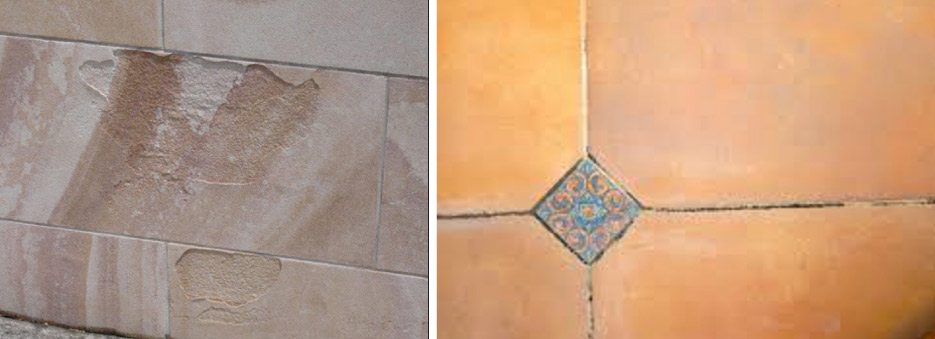Thinking About Spring Cleaning?
Navigating the Dangerous Waters of Pressure Washing Stone and Masonry Surfaces
Frederick M. Hueston, PhD
Stone Forensics
Pressure washing is a fast and easy way to clean concrete, sidewalks, driveways, and other surfaces, but when it comes to stone and masonry, did you know that pressure washing can cause damage? Also be aware that anyone can purchase a pressure washer and claim to be qualified to clean exterior stone and masonry. One should always opt to have a professional stone restoration contractor to achieve safe, lasting results. There are things you should know about if you are considering offering this service.
Oversaturation Can Cause Efflorescence
Pressure washing can remove the natural protective patina of stone and masonry surfaces. It will also remove any coating or sealers. This opens up the pores in the surface, allowing water to seep deep into the stone or masonry. The higher the pressure, the more water the stone or masonry will consume, and the more saturated it will become. Oversaturated stone or masonry can cause a condition known as Efflorescence, a white powdery residue that accumulates on the surface. This powder consists of salts originating from the stone and the setting material. The salts are dissolved from the water and deposited on the surface. In many cases the salts will deposit into the pores without making their way all the way to the surface, causing pitting, flaking and delamination.
 |
| Above, left: Efflorescence in masonry shows as white salts leaching to the surface. Above, right: Visible scars from a no-tip pressure washer can carved into the surface. |
Scarring/Gouging
In order to get difficult soiling removed, many contractors will intentionally not place tips on their pressure washers. This can cause severe scarring of the surface. It is easy to recognize scarring by deep patterns carved into the surface of the stone or masonry.
 |
| Above, left: Chemical damage as a result of improper use of chemicals. Above, right: Missing Grout. |
Chemicals
In addition to pressure washing, unqualified contractors often use inappropriate chemicals in an attempt to help remove the soiling. These chemicals are applied before and during the pressure washing process. The chemicals can be driven deep into the stone with the high water pressure, causing etching and other damage. Common chemicals are acids, bleach, and high alkaline cleaners, which if not applied and neutralized properly, can cause irreversible damage.
Missing Grout and Point
Grout on interior surfaces and pointing on exterior surfaces can be removed by pressure washing. Old grout and pointing becomes soft, weak, and cracked with age. Using a pressure washer accelerates this process through oversaturation.
The Proper Use of a Pressure Washer
Not all pressure washing is damaging, but whoever performs it needs to be aware of the following:
- The surface to be cleaned should be inspected and evaluated to determine the softness of the material – especially structurally important material.
- Grout and point should be examined carefully before washing.
- Never use a pressure washer over 1000 PSI.
- Never use a zero-point tip. Only fan tips should be used.
- Do not use bleach, acids, or high-alkaline chemicals on stone or masonry surfaces.
- The pressure washing tip should be at least 12 inches from the surface of the material being cleaned to mitigate the impact.
In order to avoid damage to your stone or masonry, always consult with a professional stone and masonry restoration contractor. This article will help you ask the right questions about training.
Dr. Frederick M. Hueston, PhD. has written over 33 books on stone and tile fabrication and installation, and also publishes a weekly podcast, The Tile and Stone Show. Fred has also been writing for the Slippery Rock for over 20 years. Send your comments to fhueston@stoneforensics.com